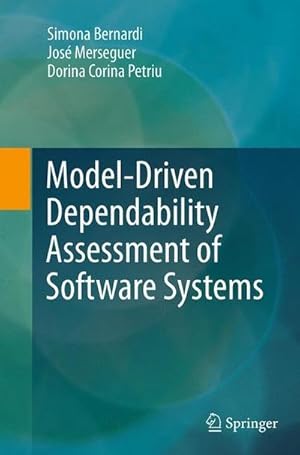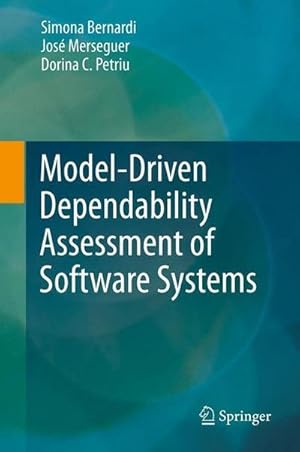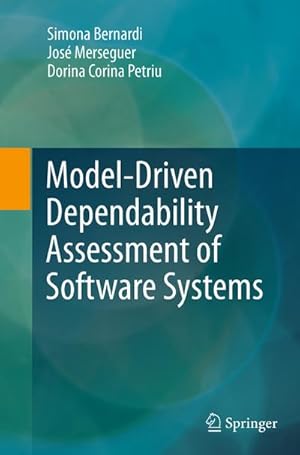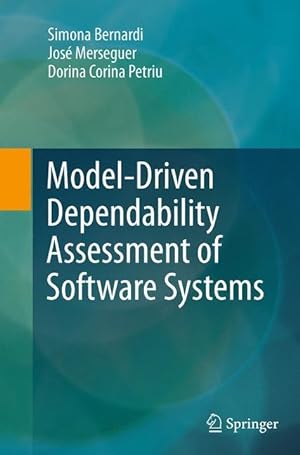Model Driven Dependability Assessment Software by Bernardi Simona (26 results)
Search filters
Product Type
- All Product Types
- Books (26)
- Magazines & Periodicals (No further results match this refinement)
- Comics (No further results match this refinement)
- Sheet Music (No further results match this refinement)
- Art, Prints & Posters (No further results match this refinement)
- Photographs (No further results match this refinement)
- Maps (No further results match this refinement)
- Manuscripts & Paper Collectibles (No further results match this refinement)
Condition Learn more
- New (23)
- As New, Fine or Near Fine (3)
- Very Good or Good (No further results match this refinement)
- Fair or Poor (No further results match this refinement)
- As Described (No further results match this refinement)
Binding
Collectible Attributes
- First Edition (No further results match this refinement)
- Signed (No further results match this refinement)
- Dust Jacket (No further results match this refinement)
- Seller-Supplied Images (13)
- Not Print on Demand (16)
Language (1)
Price
- Any Price
- Under £ 20 (No further results match this refinement)
- £ 20 to £ 40 (No further results match this refinement)
- Over £ 40
Free Shipping
- Free Shipping to U.S.A. (No further results match this refinement)
Seller Location
Seller Rating
-
Model-Driven Dependability Assessment of Software Systems
Seller: Lucky's Textbooks, Dallas, TX, U.S.A.
Condition: New.
-
Model-Driven Dependability Assessment of Software Systems
Seller: GreatBookPrices, Columbia, MD, U.S.A.
Condition: New.
-
Model-Driven Dependability Assessment of Software Systems
Seller: Lucky's Textbooks, Dallas, TX, U.S.A.
Condition: New.
-
Model-Driven Dependability Assessment of Software Systems
Seller: GreatBookPrices, Columbia, MD, U.S.A.
Condition: As New. Unread book in perfect condition.
-
Model-Driven Dependability Assessment of Software Systems
Seller: Ria Christie Collections, Uxbridge, United Kingdom
Condition: New. In.
-
Model-Driven Dependability Assessment of Software Systems
Seller: Ria Christie Collections, Uxbridge, United Kingdom
Condition: New. In.
-
Model-Driven Dependability Assessment of Software Systems
Seller: GreatBookPricesUK, Woodford Green, United Kingdom
Condition: New.
-
Model-Driven Dependability Assessment of Software Systems
Seller: Books Puddle, New York, NY, U.S.A.
Condition: New. pp. 187.
-
Model-Driven Dependability Assessment of Software Systems
Seller: GreatBookPricesUK, Woodford Green, United Kingdom
Condition: As New. Unread book in perfect condition.
-
Model-Driven Dependability Assessment of Software Systems
Seller: Books Puddle, New York, NY, U.S.A.
Condition: New. pp. 204.
-
Taschenbuch. Condition: Neu. Model-Driven Dependability Assessment of Software Systems | Simona Bernardi (u. a.) | Taschenbuch | xvi | Englisch | 2016 | Springer | EAN 9783662509425 | Verantwortliche Person für die EU: Springer Verlag GmbH, Tiergartenstr. 17, 69121 Heidelberg, juergen[dot]hartmann[at]springer[dot]com | Anbieter: preigu.
-
Model-Driven Dependability Assessment of Software Systems
Published by Springer Berlin Heidelberg, Springer Berlin Heidelberg Okt 2013, 2013
ISBN 10: 3642395112 ISBN 13: 9783642395116
Language: English
Seller: buchversandmimpf2000, Emtmannsberg, BAYE, Germany
Buch. Condition: Neu. Neuware -Over the last two decades, a major challenge for researchers working on modeling and evaluation of computer-based systems has been the assessment of system Non Functional Properties (NFP) such as performance, scalability, dependability and security.In this book, the authors present cutting-edge model-driven techniques for modeling and analysis of software dependability. Most of them are based on the use of UML as software specification language. From the software system specification point of view, such techniques exploit the standard extension mechanisms of UML (i.e., UML profiling). UML profiles enable software engineers to add non-functional properties to the software model, in addition to the functional ones. The authors detail the state of the art on UML profile proposals for dependability specification and rigorously describe the trade-off they accomplish. The focus is mainly on RAMS (reliability, availability, maintainability and safety) properties. Among the existing profiles, they emphasize the DAM (Dependability Analysis and Modeling) profile, which attempts to unify, under a common umbrella, the previous UML profiles from literature, providing capabilities for dependability specification and analysis. In addition, they describe two prominent model-to-model transformation techniques, which support the generation of the analysis model and allow for further assessment of different RAMS properties. Case studies from different domains are also presented, in order to provide practitioners with examples of how to apply the aforementioned techniques.Researchers and students will learn basic dependability concepts and how to model them usingUML and its extensions. They will also gain insights into dependability analysis techniques through the use of appropriate modeling formalisms as well as of model-to-model transformation techniques for deriving dependability analysis models from UML specifications. Moreover, software practitioners willfind a unified framework for the specification of dependability requirements and properties of UML, and will benefit from the detailed case studies.Springer Verlag GmbH, Tiergartenstr. 17, 69121 Heidelberg 204 pp. Englisch.
-
Model-Driven Dependability Assessment of Software Systems
Published by Springer Berlin Heidelberg, 2016
ISBN 10: 3662509423 ISBN 13: 9783662509425
Language: English
Seller: AHA-BUCH GmbH, Einbeck, Germany
Taschenbuch. Condition: Neu. Druck auf Anfrage Neuware - Printed after ordering - Over the last two decades, a major challenge for researchers working on modeling and evaluation of computer-based systems has been the assessment of system Non Functional Properties (NFP) such as performance, scalability, dependability and security.In this book, the authors present cutting-edge model-driven techniques for modeling and analysis of software dependability. Most of them are based on the use of UML as software specification language. From the software system specification point of view, such techniques exploit the standard extension mechanisms of UML (i.e., UML profiling). UML profiles enable software engineers to add non-functional properties to the software model, in addition to the functional ones. The authors detail the state of the art on UML profile proposals for dependability specification and rigorously describe the trade-off they accomplish. The focus is mainly on RAMS (reliability, availability, maintainability and safety) properties. Among the existing profiles, they emphasize the DAM (Dependability Analysis and Modeling) profile, which attempts to unify, under a common umbrella, the previous UML profiles from literature, providing capabilities for dependability specification and analysis. In addition, they describe two prominent model-to-model transformation techniques, which support the generation of the analysis model and allow for further assessment of different RAMS properties. Case studies from different domains are also presented, in order to provide practitioners with examples of how to apply the aforementioned techniques.Researchers and students will learn basic dependability concepts and how to model them using UML and its extensions. They will also gain insights into dependability analysis techniques through the use of appropriate modeling formalisms as well as of model-to-model transformation techniques for deriving dependability analysis models from UML specifications. Moreover, software practitioners willfind a unified framework for the specification of dependability requirements and properties of UML, and will benefit from the detailed case studies.
-
Model-Driven Dependability Assessment of Software Systems
Published by Springer Berlin Heidelberg, 2013
ISBN 10: 3642395112 ISBN 13: 9783642395116
Language: English
Seller: AHA-BUCH GmbH, Einbeck, Germany
Buch. Condition: Neu. Druck auf Anfrage Neuware - Printed after ordering - Over the last two decades, a major challenge for researchers working on modeling and evaluation of computer-based systems has been the assessment of system Non Functional Properties (NFP) such as performance, scalability, dependability and security.In this book, the authors present cutting-edge model-driven techniques for modeling and analysis of software dependability. Most of them are based on the use of UML as software specification language. From the software system specification point of view, such techniques exploit the standard extension mechanisms of UML (i.e., UML profiling). UML profiles enable software engineers to add non-functional properties to the software model, in addition to the functional ones. The authors detail the state of the art on UML profile proposals for dependability specification and rigorously describe the trade-off they accomplish. The focus is mainly on RAMS (reliability, availability, maintainability and safety) properties. Among the existing profiles, they emphasize the DAM (Dependability Analysis and Modeling) profile, which attempts to unify, under a common umbrella, the previous UML profiles from literature, providing capabilities for dependability specification and analysis. In addition, they describe two prominent model-to-model transformation techniques, which support the generation of the analysis model and allow for further assessment of different RAMS properties. Case studies from different domains are also presented, in order to provide practitioners with examples of how to apply the aforementioned techniques.Researchers and students will learn basic dependability concepts and how to model them using UML and its extensions. They will also gain insights into dependability analysis techniques through the use of appropriate modeling formalisms as well as of model-to-model transformation techniques for deriving dependability analysis models from UML specifications. Moreover, software practitioners willfind a unified framework for the specification of dependability requirements and properties of UML, and will benefit from the detailed case studies.
-
Model-driven Dependability Assessment of Software Systems
Published by Springer-Verlag New York Inc, 2016
ISBN 10: 3662509423 ISBN 13: 9783662509425
Language: English
Seller: Revaluation Books, Exeter, United Kingdom
Paperback. Condition: Brand New. reprint edition. 204 pages. 9.30x6.20x0.46 inches. In Stock.
-
Model-Driven Dependability Assessment of Software Systems
Published by Springer Berlin Heidelberg, 2013
ISBN 10: 3642395112 ISBN 13: 9783642395116
Language: English
Seller: Buchpark, Trebbin, Germany
Condition: Sehr gut. Zustand: Sehr gut | Sprache: Englisch | Produktart: Bücher.
-
Condition: new. Questo è un articolo print on demand.
-
Model-Driven Dependability Assessment of Software Systems
Published by Springer Berlin Heidelberg Aug 2016, 2016
ISBN 10: 3662509423 ISBN 13: 9783662509425
Language: English
Seller: BuchWeltWeit Ludwig Meier e.K., Bergisch Gladbach, Germany
Taschenbuch. Condition: Neu. This item is printed on demand - it takes 3-4 days longer - Neuware -Over the last two decades, a major challenge for researchers working on modeling and evaluation of computer-based systems has been the assessment of system Non Functional Properties (NFP) such as performance, scalability, dependability and security.In this book, the authors present cutting-edge model-driven techniques for modeling and analysis of software dependability. Most of them are based on the use of UML as software specification language. From the software system specification point of view, such techniques exploit the standard extension mechanisms of UML (i.e., UML profiling). UML profiles enable software engineers to add non-functional properties to the software model, in addition to the functional ones. The authors detail the state of the art on UML profile proposals for dependability specification and rigorously describe the trade-off they accomplish. The focus is mainly on RAMS (reliability, availability, maintainability and safety) properties. Among the existing profiles, they emphasize the DAM (Dependability Analysis and Modeling) profile, which attempts to unify, under a common umbrella, the previous UML profiles from literature, providing capabilities for dependability specification and analysis. In addition, they describe two prominent model-to-model transformation techniques, which support the generation of the analysis model and allow for further assessment of different RAMS properties. Case studies from different domains are also presented, in order to provide practitioners with examples of how to apply the aforementioned techniques.Researchers and students will learn basic dependability concepts and how to model them using UML and its extensions. They will also gain insights into dependability analysis techniques through the use of appropriate modeling formalisms as well as of model-to-model transformation techniques for deriving dependability analysis models from UML specifications. Moreover, software practitioners will find a unified framework for the specification of dependability requirements and properties of UML, and will benefit from the detailed case studies. 204 pp. Englisch.
-
Model-Driven Dependability Assessment of Software Systems
Published by Springer Berlin Heidelberg Okt 2013, 2013
ISBN 10: 3642395112 ISBN 13: 9783642395116
Language: English
Seller: BuchWeltWeit Ludwig Meier e.K., Bergisch Gladbach, Germany
Buch. Condition: Neu. This item is printed on demand - it takes 3-4 days longer - Neuware -Over the last two decades, a major challenge for researchers working on modeling and evaluation of computer-based systems has been the assessment of system Non Functional Properties (NFP) such as performance, scalability, dependability and security.In this book, the authors present cutting-edge model-driven techniques for modeling and analysis of software dependability. Most of them are based on the use of UML as software specification language. From the software system specification point of view, such techniques exploit the standard extension mechanisms of UML (i.e., UML profiling). UML profiles enable software engineers to add non-functional properties to the software model, in addition to the functional ones. The authors detail the state of the art on UML profile proposals for dependability specification and rigorously describe the trade-off they accomplish. The focus is mainly on RAMS (reliability, availability, maintainability and safety) properties. Among the existing profiles, they emphasize the DAM (Dependability Analysis and Modeling) profile, which attempts to unify, under a common umbrella, the previous UML profiles from literature, providing capabilities for dependability specification and analysis. In addition, they describe two prominent model-to-model transformation techniques, which support the generation of the analysis model and allow for further assessment of different RAMS properties. Case studies from different domains are also presented, in order to provide practitioners with examples of how to apply the aforementioned techniques.Researchers and students will learn basic dependability concepts and how to model them using UML and its extensions. They will also gain insights into dependability analysis techniques through the use of appropriate modeling formalisms as well as of model-to-model transformation techniques for deriving dependability analysis models from UML specifications. Moreover, software practitioners will find a unified framework for the specification of dependability requirements and properties of UML, and will benefit from the detailed case studies. 204 pp. Englisch.
-
Model-Driven Dependability Assessment of Software Systems
Published by Springer Berlin Heidelberg, 2016
ISBN 10: 3662509423 ISBN 13: 9783662509425
Language: English
Seller: moluna, Greven, Germany
Condition: New. Dieser Artikel ist ein Print on Demand Artikel und wird nach Ihrer Bestellung fuer Sie gedruckt. Comprehensive overview of standards-based dependability modeling and analysisPresentation based on the standard extension mechanisms of UMLDetailed case studies to illustrate single process stepsCo-authored by contributors to related.
-
Model-Driven Dependability Assessment of Software Systems
Published by Springer Berlin Heidelberg, 2013
ISBN 10: 3642395112 ISBN 13: 9783642395116
Language: English
Seller: moluna, Greven, Germany
Condition: New. Dieser Artikel ist ein Print on Demand Artikel und wird nach Ihrer Bestellung fuer Sie gedruckt. Comprehensive overview of standards-based dependability modeling and analysisPresentation based on the standard extension mechanisms of UMLDetailed case studies to illustrate single process stepsCo-authored by contributors to related.
-
Model-Driven Dependability Assessment of Software Systems
Seller: Majestic Books, Hounslow, United Kingdom
Condition: New. Print on Demand pp. 187.
-
Model-Driven Dependability Assessment of Software Systems
Seller: Majestic Books, Hounslow, United Kingdom
Condition: New. Print on Demand pp. 204 55 Illus.
-
Model-Driven Dependability Assessment of Software Systems
Seller: Biblios, Frankfurt am main, HESSE, Germany
Condition: New. PRINT ON DEMAND pp. 204.
-
Model-Driven Dependability Assessment of Software Systems
Seller: Biblios, Frankfurt am main, HESSE, Germany
Condition: New. PRINT ON DEMAND pp. 187.
-
Model-Driven Dependability Assessment of Software Systems
Published by Springer Berlin Heidelberg, Springer Berlin Heidelberg Aug 2016, 2016
ISBN 10: 3662509423 ISBN 13: 9783662509425
Language: English
Seller: buchversandmimpf2000, Emtmannsberg, BAYE, Germany
Taschenbuch. Condition: Neu. This item is printed on demand - Print on Demand Titel. Neuware -Over the last two decades, a major challenge for researchers working on modeling and evaluation of computer-based systems has been the assessment of system Non Functional Properties (NFP) such as performance, scalability, dependability and security.In this book, the authors present cutting-edge model-driven techniques for modeling and analysis of software dependability. Most of them are based on the use of UML as software specification language. From the software system specification point of view, such techniques exploit the standard extension mechanisms of UML (i.e., UML profiling). UML profiles enable software engineers to add non-functional properties to the software model, in addition to the functional ones. The authors detail the state of the art on UML profile proposals for dependability specification and rigorously describe the trade-off they accomplish. The focus is mainly on RAMS (reliability, availability, maintainability and safety) properties. Among the existing profiles, they emphasize the DAM (Dependability Analysis and Modeling) profile, which attempts to unify, under a common umbrella, the previous UML profiles from literature, providing capabilities for dependability specification and analysis. In addition, they describe two prominent model-to-model transformation techniques, which support the generation of the analysis model and allow for further assessment of different RAMS properties. Case studies from different domains are also presented, in order to provide practitioners with examples of how to apply the aforementioned techniques.Researchers and students will learn basic dependability concepts and how to model them usingUML and its extensions. They will also gain insights into dependability analysis techniques through the use of appropriate modeling formalisms as well as of model-to-model transformation techniques for deriving dependability analysis models from UML specifications. Moreover, software practitioners willfind a unified framework for the specification of dependability requirements and properties of UML, and will benefit from the detailed case studies.Springer Verlag GmbH, Tiergartenstr. 17, 69121 Heidelberg 204 pp. Englisch.
















